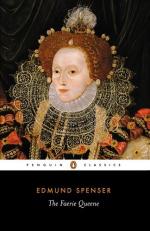1. Observe that stanza i contains the moral of Canto IX. 2. What was Una’s purpose in bringing the Knight to the House of Holiness? 3. Why should Faith and Hope be represented as betrothed virgins, and Charity a matron? 4. Who were Zeal, Reverence, Obedience, Patience, and Mercy, with the symbolism of each? 5. Who was the door-keeper? Explain the allegory. 6. Find and explain the biblical allusions in this Canto, which shows the influence of the Bible to a remarkable extent. 7. In what was the Knight instructed by Faith (xix seq.)? 8. Compare the mood of the Knight in xxi with that in Canto IX, li. 9. How did the two situations affect Una? 10. Note the teachings in xxiii (prayer), xxiv (absolution), and xxv (mortification of the flesh). 11. Observe that Faith teaches the Knight his relations to God; Charity, those to his fellow-men. 12. Explain the lyric note in l. 378. 13. Give an account of the knight’s visit to the Hill of Contemplation. Explain the allegory. 14. Find a stanza complimentary to Queen Elizabeth. 16. What prophecy was made of the Knight?
CANTO XI
I. The Plot: The Redcross Knight reaches the Brazen Tower in which Una’s parents, the King and Queen of Eden, are besieged by the Dragon. The monster is described. The first day’s fight is described, in which the Knight is borne through the air in the Dragon’s claws, wounds him under the wing with his lance, but is scorched by the flames from the monster’s mouth. The Knight is healed by a bath in the Well of Life. On the second day the Knight gives the Dragon several sword-wounds, but is stung by the monster’s tail and forced to retreat by the flames. That night he is refreshed and healed by the balm from the Tree of Life. On the third day he slays the Dragon by a thrust into his vitals.
II. The Allegory: 1. Mankind has been deprived of Eden by Sin or Satan (Dragon). The Christian overcomes the devil by means of the whole armor of God (shield of faith, helmet of salvation, sword of the Spirit, etc.). The soul is strengthened by the ordinances of religion: baptism, regeneration, etc.
2. There is a hint of the long and desperate struggle between Reformed England (St. George) and the Church of Rome, in which the power of the Pope and the King of Spain was broken in England, the Netherlands, and other parts of Europe. Some may see a remoter allusion to the delivery of Ireland from the same tyranny.
13. BE AT YOUR KEEPING WELL, be well on your guard.
iii. This stanza is not found in the edition of 1590.
30. AND SEEMD UNEATH, etc., and seemed to shake the steadfast ground (so that it became) unstable. Church and Nares take uneath to mean “beneath” or “underneath”; Kitchin conjectures “almost.”
31. THAT DREADFUL DRAGON, symbolical of Satan. Spenser here imitates the combat between St. George and the Dragon in the Seven Champions of Christendom, i.




